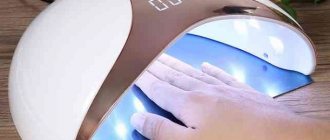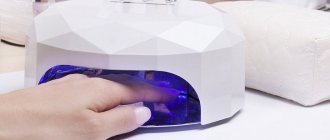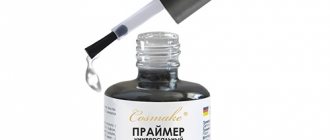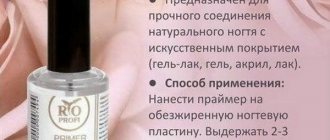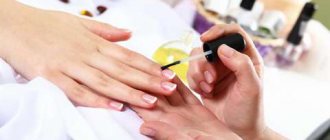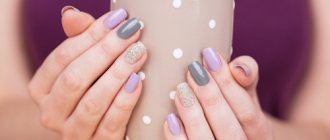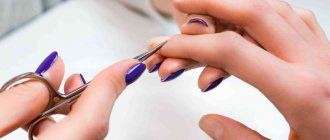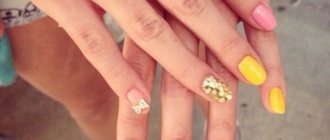Dry the gel polish for 10-60 seconds in a hybrid, LED or CCFL lamp, 2-3 minutes in an ultraviolet lamp. The time depends on the power of the device; the fastest process occurs at 36-48 W. It is important to hold your hand straight in the lamp and dry your thumb separately.
If the coating does not polymerize well, perhaps it is time to wash the device, change it, or the problem is that the gel polish is highly pigmented or its layer is too thick. Some flower beds dry only with UV radiation.
How long to dry gel polish depending on the type of lamp (minutes, seconds)
How long to dry gel polish largely depends on the power of the polymerizing device:
- In a 36 W lamp the process will take from 10 seconds to 2-3 minutes. This version of the device is optimal for home use.
- A 48-watt device will dry the coating in 10-120 seconds. The polymerization of the base will take less time, and the flower bed and finish will take more time.
- The 9-watt device will dry your nails in 1-6 minutes. Such low-power pocket lamps are usually bought for home, wanting to save money, but those who have tried them do not recommend their use. They are unreliable. Not all gel polishes can be used with mini-devices; sometimes the lower layers of the coating remain wet, only the top one dries out.
- A 54-watt lamp will polymerize the material in 10-60 seconds. These devices should not be used at home; they are more suitable for salons.
How long to dry the gel polish depends on the properties of the flower garden itself. Heavily pigmented materials take longer to polymerize, precisely because of the amount of pigment itself. It takes more time to dry each layer of gel polish if they are thick, that is, a product with a thick texture. Sometimes the required duration of the procedure is indicated on the bottle, but without taking into account the type and power of the lamp. And one more important nuance: usually the base hardens faster than the flower bed or topcoat.
The rate of polymerization also depends on the type of device used:
- Ultraviolet is the most common and cheapest, but also slow. They come from 9 to 54 watts.
- LEDs polymerize the coating faster, but are also more expensive. The power of the devices is the same as that of the previous type.
- Hybrid ones work even faster than LED ones. And they are as safe as possible, but they are also more expensive than both of the above types.
- The CCFL lamp is an improved version of the ultraviolet lamp. And it dries the coating faster.
IN ICE
The coating drying time in an LED lamp is:
- 1 minute at device power of 9 W;
- 0.5 minutes or a little less if the indicator is 18 W;
- 10-30 seconds at 36 or 48 W.
The rate of polymerization depends on the properties of the gel polish, and sometimes it has to be checked experimentally. It may seem that the coating has frozen, but only the top layer dries. And underneath the product remains wet, causing the design to separate from the ends of the nails or even from the base.
UV
The UV device will harden the coating in:
- 4-6 minutes if its power is 9 W;
- 3-4 minutes at 18 or 24 W;
- 2 minutes at a power of 36 or 48 W.
Materials with a large amount of pigment may take longer to dry. It seems that this is not very convenient, and it is time to change all polymerizing devices to more modern ones. But ultraviolet lamps dry out any coating, and, for example, LED lamps are not suitable for every gel polish.
In hybrid
In a hybrid “stove,” polymerization takes from 10 to 60 seconds, sometimes it’s worth holding your hand in it for 1.5 minutes. These devices combine UV and LED light, or they have a combination of cold cathode coil (CCFL) and LED. The first type is more common. But you will have to dry the gel polish in a UV/LED lamp for the same amount of time as in a CCFL/LED lamp.
CCFL lamp
A CCFL-type device will dry the coating layer in 10-60 seconds, since it combines cathode radiation with LED radiation. On average, polymerization takes half a minute. The duration of the procedure is affected by the density and pigmentation of the material.
Indicators characterizing the operation of lamps
The first thing you should pay attention to is power. It determines how long to dry the gel polish in the lamp. UV devices produce from 9 to 54 W. The lowest power is only suitable for home use, as it takes a long time to dry (up to 6 minutes). The best option is 36 W. How many minutes does it take to dry gel polish in a 36-watt lamp? 120 seconds is enough for the coating to dry completely. 54 W devices are used only in nail salons.
Ice lamps have a power of 12-45 W. Polymerization of the coating takes only 10-30 seconds. Wave radiation (its range) in UV units allows you to dry any shellac, this is their main difference from Ice lamps. However, Ice equipment does not heat up during operation; it can be called “icy”, unlike its opponent. The performance capabilities of Ice lamps are much higher than those of UV units. If the UV device is burnt out, it can be easily replaced, but in the case of LED, restoration cannot be carried out. Ice equipment is compact in size, which cannot be said about UV lamps.
It is possible to dry the coating in half a minute using a hybrid lamp. It helps in working with gels, biogels, colored shellacs and ice materials. The device includes:
- 12 ice bulbs;
- 1 spiral lamp.
The main advantage is the short drying time. The versatility of the lamp is an undoubted advantage of the “unit”. Device power – 36 W. The diodes take on 24 W, and 12 “pull” the spiral. A regular gel polymerizes in a minute.
How to dry gel polish
Gel polish should be dried following several rules:
- Each layer is polymerized. First, the base is applied by rubbing in, then with leveling, after which the hand is sent into the lamp for the first time. Next they apply a flower bed and also dry it. Then, for brightness, they paint with another layer and it is polymerized. A finishing coat is applied to the dry gel polish and dried.
- It is important to position your hand correctly for the polymerization process. To properly dry gel polish, the brush should lie flat, parallel to the table surface. If it is turned on its side, the material will flow. The fingers should not be pressed together; the hand should be relaxed.
- The brush cannot be removed from the “oven” during the entire polymerization time. Otherwise, the process will be disrupted, the coating will dry unevenly, which is why detachments will appear later.
- You should dry your thumbnails with gel polish separately in a lamp. The hand is placed inside so that the plate is parallel to the table top. You should not put your thumb on its side, this is also fraught with the appearance of streaks and poor-quality polymerization.
All layers of gel polish must be dried until completely cured, maintaining the required time. When the material has cooled slightly, it is necessary to remove residual stickiness. Almost all flower beds have it, but this does not mean that the coating has not dried out.
Which lamp is better
Gel polish should be dried with a lamp suitable for this product, this can be understood from the information on the bottle. It is marked with:
- UV – ultraviolet device only;
- LED – an LED lamp should be used;
- UV/LED – the product dries under both types of radiation.
If there is no such marking on the bottle, it means that it can be polymerized in any device, including a hybrid type.
A lamp with new lamps with a power of 36-48 W dries gel polish better, regardless of the type. In this case, its real indicator corresponds to the nominal one, and it is impossible to make a mistake with the duration of the process and leave the layer of material wet. Such devices have several light sources, so the nails are evenly exposed. And their different parts dry out equally well.
Problems arise with 9 and 18 W devices. They require long-term polymerization, but even if the curing time is observed, the product may not dry out in deep layers. This is caused not only by insufficient power, but also by a small number of radiation sources.
Gel polish dries quickly with an LED or hybrid lamp with a power of 36-48 W. In addition, this type of lamp lasts longer during active use. The LEDs have the same qualities, working together for 50 thousand hours. And ultraviolet lamps can maintain the brightness as at the beginning of operation, but their power decreases after 2-3 months of active use.
If without a lamp at home
It is possible to polymerize gel polish without a lamp at home using improvised means, but you should not count on a good quality manicure:
- Use ice baths. Dip your fingertips into a bowl with water and pieces of ice and hold for up to 10-15 minutes. The cold will harden the coating, but your hands will also get very cold.
- First place the bottle with the product in the refrigerator. After this, it is applied to the nails. Gel polish thickens significantly, which is why it dries faster. But it can lie on the plates in lumps.
- Special catalysts are used. This is an ointment, spray or gel that is applied over the flower bed. Catalysts are produced by different companies.
- With the help of the sun's rays. You can dry gel polishes by going outside, but not in the shade. After all, the sun's rays are also ultraviolet. But the procedure will take much longer, and you cannot vouch for the longevity of the manicure.
- Using a medical lamp with blue radiation (Minin reflector). It emits infrared rays, not ultraviolet, so the polymerization procedure will also be long. And the quality of drying will leave much to be desired.
Some people recommend using a hairdryer or fan to harden the coating. But these are the least reliable methods. The flow of warm air will cause gel polish to ripple rather than dry.
Power
Lamps are available in different wattages, and this determines how long shellac needs to be dried in each of these lamps:
- UV lamps are available in several powers from 9 W to 54 W. The 9 W lamp is intended for manicure at home and one layer of shellac is polymerized in 4-6 minutes (this is written in the instructions for the lamp). However, this drying time is not suitable for everyone. The most optimal in this regard is a 36 W UV lamp. How long does it take to dry shellac in a 36 W lamp? According to reviews from those who have already tried such lamps, we can say that two minutes of drying is enough for the shellac to polymerize well. UV lamps 54 W are used only in beauty salons;
- LED lamps are produced with powers from 12 W to 45 W. This power is enough to polymerize shellac in a time period of 10 to 30 seconds.
How long to dry the gel polish base?
The gel polish base should be dried for the same amount of time as a flower bed, that is, from 30 seconds in an LED or hybrid lamp and from 2 minutes in an ultraviolet lamp. This is provided that the device is powerful enough - 36-48 W.
Transparent bases with a liquid consistency may polymerize faster, but not much. Camouflage ones can be as dense as flower beds. Therefore, in any case, you should not save on polymerization time. After all, bases are often applied in a fairly thick layer to even out the nail plate. And if you don’t dry it well, the coating won’t last long. Sometimes the bottle with the product indicates the recommended polymerization time.
The correct way to dry a gel polish base is as follows:
- Apply a thin rubbing layer.
- Use a drop for leveling, distribute, respecting the architecture of the nail.
- Place your finger in the lamp so that the plate is evenly exposed to radiation and the product does not flow from it.
- Maintain the allotted time.
- Repeat steps 1-4 for each nail plate.
Experienced masters immediately apply the base to the nails of 4 fingers, then dry. Separately, they deal with the larger ones and place them in the lamp in the same way as the rest. That is, the finger should be parallel to the surface of the table on which the device is located.
Do I need to dry the primer?
The primer must be dried before applying the base, but not in a lamp, but in air. This watery product does not polymerize. Its liquid component evaporates, leaving a white coating on the nail, a slight stickiness and drying out the surface of the plate. If you also use a lamp, the effect will be too aggressive. Fragile nails can be damaged, so do not speed up the evaporation period of the primer. It will dry out in a minute.
Is a procedure necessary for the top?
The top, which is applied over the flower bed for gloss or matte, must be polymerized in a lamp. This product hardens only when exposed to radiation. If you leave the topcoat liquid, it will not dry out on its own, but will simply be erased. And the top is needed not only for the external completeness of the manicure, but also to protect the color from fading and mechanical damage.
Why does the lamp dry gel polish poorly or not at all?
Sometimes it is discovered that the lamp does not dry the gel polish well or does not dry it at all, and this may mean that:
- It's time to change the device. Light sources may look the same, but their power decreases over time.
- The flower bed is well pigmented. And these are not necessarily bright or dark shades, it could be white or beige. The pigment prevents radiation from completely affecting the layer, so the coating takes longer to polymerize.
- It's time to throw away the gel polish. Perhaps it has expired, or the product has deteriorated due to improper storage. Some brands of flower beds are counterfeited. Due to the absence of the necessary components in the composition, polymerization does not occur.
- The product was applied in a thick layer. And after the allotted time for drying, it is discovered that it has polymerized only on top, and remains wet at the bottom.
- The wrong type of dryer is being used. Some gel polishes are polymerized only in a UV lamp, and LED does not have any effect on them.
- The light sources in the device are dirty. Due to dust or gel polish that gets on their surface, the radiation power weakens and the coating does not harden.
- The drying technology is broken. This may be an incorrect placement of the hand in the “stove”. The problem will arise if in the process you endlessly pull it out and look at the manicure.
- The device has insufficient power. The indicator is not compatible with thick layers of coating and highly pigmented flower beds.
Sometimes the reason that the lamp does not dry the gel polish is not the product or device used, but the fact that the sticky layer was not removed. All flower beds, as a rule, have it. And if you touch the surface, your finger sticks, it seems that the coating has not dried. You need to wait a couple of minutes until it cools down and wipe your nails with clinser or alcohol.
Why does the coating roll up?
The same circumstances are to blame for gel polish curling:
- low-power or exhausted lamp;
- excessively thick coating layer;
- thick manicure product that requires more time to polymerize;
- low-quality gel polish or expired product.
Why does your nail burn when you dry gel polish?
It happens that when you dry gel polish, the nail burns, although this should not normally happen, the cause of the problem can be:
- too thick layer of material, due to which excess heat is released during polymerization;
- a powerful lamp, due to which the radiation is intense;
- features of the product used (transparency or components in the composition that easily transmit light from sources);
- thinned, damaged and therefore painful nail plate;
- low pain threshold, which may be due to hormones (pregnancy, PMS);
- poor quality base or gel polish.
If it burns, you need to remove your hand from the device. And continue drying when the feeling goes away.
How long does it take to dry gel polish in different types of lamps?
The polymerization process of the coating in different types of dryers lasts different amounts of time, much depends on the number of light bulbs in the device. For your home, you should look for a small lamp with a minimum power consumption of 9 W. Drying will take about 7-10 minutes.
Masters prefer 36 W models. Gel polish in such models dries from 30 seconds to a minute. 48 W devices are purchased for use in nail salons. They are considered professional equipment, are more expensive and polymerize gel polish from 15 seconds to half a minute.
When choosing a lamp for gel polish, you need to consider the following nuances:
- LED ones are small in size, but do not dry all types of gel polishes;
- ultraviolet ones dry out all coatings, but have a negative effect on the organs of vision and on the nail plate, and have large volumes;
- hybrids dry gel polish in less than 30 seconds, but are more expensive than their LED and fluorescent lamp counterparts.
Is it possible to overdry the coating?
To dry the coating enough for it to become noticeable, you need to hold your hand in the lamp for a long time. But if you polymerize it for more than the specified time, this will lead to a reduction in the period of wearing the manicure. The coating will begin to peel off, crack, and deform. To avoid this, you should use a clock during the drying process or buy a lamp with a timer.
Not only the appearance of the manicure, but also the duration of its wearing depends on the quality of polymerization. Therefore, it is important to have a high-quality lamp and take care of it. And it is not necessary to have the most powerful device; 36-48 W is enough.

